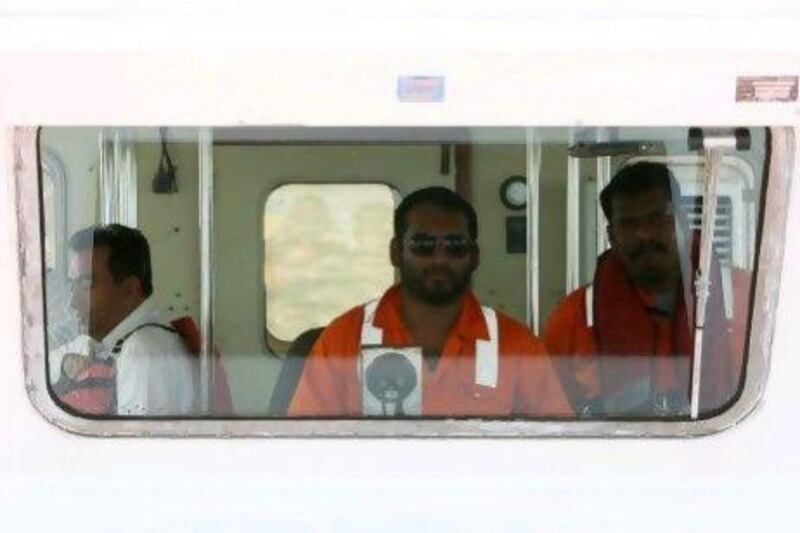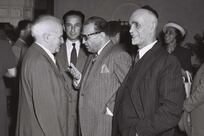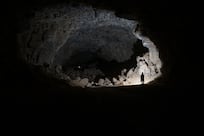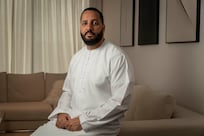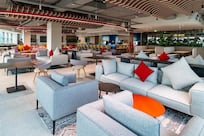It's 9am on a weekday, and the volume of incoming traffic at Jebel Ali's Gate 4 reaches a climax as another working day begins for the Gulf's busiest port.
Full steam ahead
Shipping The National charts the success of the UAE's maritime industry as it navigates choppy financial waters. Learn more
The arm of the barrier rises every couple of seconds to let through another worker, customer or visitor to the port. The day is already too hot for standing outside, so I wait inside the security complex for an executive who will be my guide through the beating heart of Dubai's commercial life.
On the other side of the gates lies Dubai's biggest and most significant infrastructure investment, an indispensable piece of the economy of the emirate, and of the UAE.
Since it was conceived in the 1970s, Jebel Ali has been arguably the emirate's greatest commercial success. Emirates Airline and Dubai International Airport may be the first port of call for millions of air passengers and tourists, and the beach hotels and malls their main destinations, but Jebel Ali is by far the biggest conduit for the goods and commodities that built Dubai into the Gulf's most important trading hub. It is the business end of Dubai commerce.
According to official figures, Jebel Ali and its connected industrial free zone, Jafza, contribute more than a quarter of Dubai's GDP, account for 50 per cent of the emirate's exports and 20 per cent of all foreign direct investment in the UAE.
Without Jebel Ali, Dubai's transformation from a pearl centre and fishing port to a modern, sophisticated metropolis could not have been completed. Other dock facilities were there before - the Creek wharfage, then the facilities at Port Rashid - but Jebel Ali was a quantum leap in the emirate's commercial life.
My guide arrives, and we set off on the tour. Anas Saleh is a communications executive at DP World, the group that operates the port facilities at Jebel Ali.
What strikes you first and hardest is the scale of the operation. The map the executive hands me is not drawn to scale, and it shows model ships overshadowing apparently minuscule dockyard facilities; in fact, though the ships are some of the biggest cargo carriers in the world, each bearing up to 15,000 20-foot equivalent units, or shipping containers. The port itself is enormous: 5 million square metres, equivalent to the area of more than 700 rugby pitches.
The ships, giants lying at berth in the 17-metre deep port, are matched by the 40 metre high gantry cranes unloading the cargoes. About 80 of these Chinese-built mega-cranes are in use in the port, among a total of 200 big lifting devices.
Getting around on foot would be impossible, so Jebel Ali has its own transport system, as well as its own shops, residential areas, administrative and civil facilities - fire, immigration and customs, police and hospitals. About 130,000 people work in Jafza by day, but even when the commuters go home, there is a permanent residential population of 57,000. It is virtually a semi-autonomous city within the emirate.
Mr Saleh gives me a short history lesson. Aerial photographs show the Jebel Ali site in 1977, just after work began on what had been an unbroken coastline of desert beach. A couple of little jetties protrude into the Gulf waters, and a small cutting into the coastline shows the beginnings of the modern port.
Fast-forward to 1997, and two gigantic fissures have been gouged into the land, corresponding to what are now terminals 1 and 2 of the main port.
Jump forward again, and by 2009, a third terminal is taking shape out of sand and earth reclaimed from the Gulf. When terminal 3 opens in a few years, depending on world trading conditions, Jebel Ali will be challenging for the title of the world's biggest port.
It is already the biggest man-made harbour in the world, and the biggest port between Singapore and Rotterdam. Its existence is a testimony to the vision of successive Rulers of Dubai, but also to the determination of Sultan bin Sulayem, the former chairman of the Dubai World conglomerate, who oversaw its expansion over two decades of growth.
"Mr bin Sulayem started with zero, now look," says my guide, with a sweep of an arm.
By now, we are in the basin of terminal 1, the oldest and biggest. It stretches from a naval area in the west, where ships from the navies of the US and UAE are docked, to a roll-on roll-off facility in the east, where vehicles are off-loaded and stored, waiting for delivery to the showrooms of the Gulf.
Along the way, for a distance of 14km, are refrigerated storage facilities, general cargo warehouses, secure chemical storage areas and many more gantries swinging containers from ships directly on to waiting lorries. Many of the big names of global and regional commerce are represented on the buildings and warehouses that line the dockside: Al-Futtaim, Honda, Nissan, Maersk, United Arab Shipping, McDermott rigs of the US.
Terminal 2 (T2), which opened in 2007, is part general and commodity cargo, with more container unloading facilities on its northern side. Oil storage facilities, grain, general commodities, timber yards and raw materials storage for the Dubai Aluminium plant cover hectare after hectare. Bang in the middle is the huge sugar storage dome with the name of Dubai's Al Ghurair family painted on its side in enormous letters.
At the T2 operations centre, staff work round the clock to ensure the smooth operation of the logistical and security processes. Banks of screens give instant details on the status of vessels and cargoes coming into the terminal. Colour coding delineates the size and condition of vessels, and all individual containers on board are separately marked and tracked on one of the 16 screens in the control room.
"It's a bit like an airport. The ships are the airplanes and the containers are the passengers. We can see them all from here," says a technician.
The operation is vaguely reminiscent of movie representations of a military war room. Security measures are apparent everywhere. In the room marked "security command and control", more staff watch screens showing images from the 260 cameras that cover the entire port area. They are on the lookout for intruders, anyone opening containers without authorisation, and other general security situations, such as crew members disembarking without permission.
One operator zooms in on an employee loitering suspiciously at the end of a container but relaxes again when the man's colleague arrives and the two workers begin their shift.
Security is tight, especially for dockyard labourers. All containers are sealed until delivered to their destinations and claimed, and their contents are scanned twice - once by the operator DP World and again by customs.
On the north shore of T2, there is another mass of gantries and quay cranes, some so big they have to move on rail tracks rather than rubber tyres. In the near distance, you can make out what will be, in a few years, the new terminal 3. It is slowly being created from the huge deposits of sand brought up by the dredging for terminal 2.
Organising the traffic of vessels in and out of the port is a complex task overseen from the main control tower on the western side of the port. From here, operators get a panoramic take on ships as they move into the port, heading for one of the terminals.
Captain Ahmed bin Dalmook comes from an old Dubai pearl trading family, but trained for 14 years to become the assistant harbour master at Jebel Ali. He explains, with evident pride, that he organises about 70 ship movements in the port on a normal day.
"It is a 24-hour operation, and the entrance is comparatively narrow, so we need pilots to bring them in and out," he says. "We can handle up to around 100 vessels a day, so it gets a bit busy at times. Fog and high winds can slow us down sometimes too."
We watch as a gigantic car carrier, originating in Japan with a stop in Singapore before continuing to Oman and the UAE, negotiates its way carefully down the main channel, with a tugboat and pilot boat at its side.
Just a few minutes after it has passed, another big ship, this time an Indonesian container vessel, last stop Bandar Abbas in Iran en route to Aden via Jebel Ali, looms out of the heat-haze, and steams towards its berth to unload cargo. It will be going out again within a few hours. This is the maritime equivalent of rush hour on Sheikh Zayed Road.
As a seafaring man, CaptDalmook is happiest when aboard the powerful tugboat Rubban, cruising through the port at up to 20 knots. From the water, you get a proper sense of the size of the place: looking from the tip of the breakwater, the huge port facilities of terminal 1, that loomed so large onshore, are dots on the horizon.
The tug bears the livery of P&O Marine, harking back to the deal in 2006 that made DP World a leading global company with the acquisition of the British ports and shipping group. But even within the enlarged global DP World, Jebel Ali still accounts for about 50 per cent of profits.
We finish the final stage of the water tour with a look at the liquid natural gas terminal, on the seaward edge of the port area, where a Qatari tanker is hooked up to the pipeline and unloading a cargo that will help keep Dubai running, and growing.
"I have great pride in Jebel Ali port, and the role it's played in Dubai's development," says Capt Dalmook. "We are planning to keep it growing for years to come."
